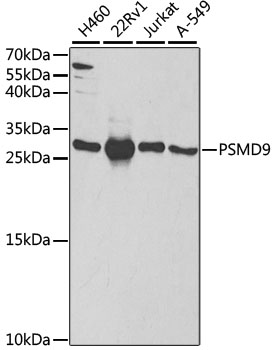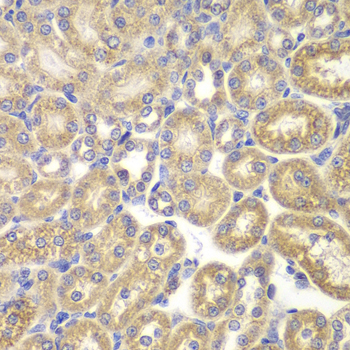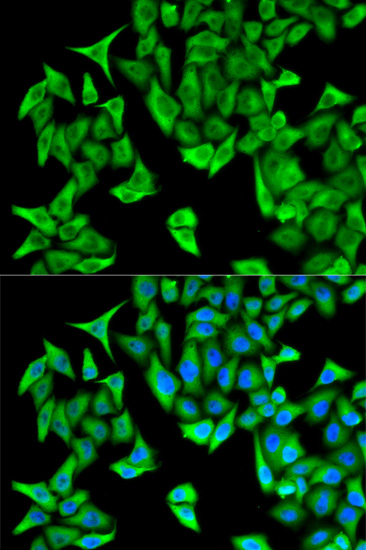Cell Biology Antibodies 9
Anti-PSMD9 Antibody (CAB5357)
- SKU:
- CAB5357
- Product Type:
- Antibody
- Reactivity:
- Human
- Reactivity:
- Mouse
- Reactivity:
- Rat
- Host Species:
- Rabbit
- Isotype:
- IgG
- Antibody Type:
- Polyclonal Antibody
- Research Area:
- Cell Biology
Description
| Antibody Name: | Anti-PSMD9 Antibody |
| Antibody SKU: | CAB5357 |
| Antibody Size: | 20uL, 50uL, 100uL |
| Application: | WB IHC IF |
| Reactivity: | Human, Mouse, Rat |
| Host Species: | Rabbit |
| Immunogen: | Recombinant fusion protein containing a sequence corresponding to amino acids 1-223 of human PSMD9 (NP_002804.2). |
| Application: | WB IHC IF |
| Recommended Dilution: | WB 1:500 - 1:2000 IHC 1:50 - 1:200 IF 1:50 - 1:200 |
| Reactivity: | Human, Mouse, Rat |
| Positive Samples: | H460, 22Rv1, Jurkat, A-549 |
| Immunogen: | Recombinant fusion protein containing a sequence corresponding to amino acids 1-223 of human PSMD9 (NP_002804.2). |
| Purification Method: | Affinity purification |
| Storage Buffer: | Store at -20'C. Avoid freeze / thaw cycles. Buffer: PBS with 0.02% sodium azide, 50% glycerol, pH7.3. |
| Isotype: | IgG |
| Sequence: | MSDE EARQ SGGS SQAG VVTV SDVQ ELMR RKEE IEAQ IKAN YDVL ESQK GIGM NEPL VDCE GYPR SDVD LYQV RTAR HNII CLQN DHKA VMKQ VEEA LHQL HARD KEKQ ARDM AEAH KEAM SRKL GQSE SQGP PRAF AKVN SISP GSPA SIAG LQVD DEIV EFGS VNTQ NFQS LHNI GSVV QHSE GKPL NVTV IRRG EKHQ LRLV PTRW AGKG LLGC NIIP LQR |
| Gene ID: | 5715 |
| Uniprot: | O00233 |
| Cellular Location: | |
| Calculated MW: | 13kDa/22kDa/24kDa |
| Observed MW: | 25kDa |
| Synonyms: | PSMD9, Rpn4, p27 |
| Background: | The 26S proteasome is a multicatalytic proteinase complex with a highly ordered structure composed of 2 complexes, a 20S core and a 19S regulator. The 20S core is composed of 4 rings of 28 non-identical subunits; 2 rings are composed of 7 alpha subunits and 2 rings are composed of 7 beta subunits. The 19S regulator is composed of a base, which contains 6 ATPase subunits and 2 non-ATPase subunits, and a lid, which contains up to 10 non-ATPase subunits. Proteasomes are distributed throughout eukaryotic cells at a high concentration and cleave peptides in an ATP/ubiquitin-dependent process in a non-lysosomal pathway. An essential function of a modified proteasome, the immunoproteasome, is the processing of class I MHC peptides. This gene encodes a non-ATPase subunit of the 19S regulator. Three transcript variants encoding two different isoforms have been found for this gene. |
| UniProt Protein Function: | PSMD9: Acts as a chaperone during the assembly of the 26S proteasome, specifically of the base subcomplex of the PA700/19S regulatory complex (RC). During the base subcomplex assembly is part of an intermediate PSMD9:PSMC6:PSMC3 module, also known as modulator trimer complex; PSMD9 is released during the further base assembly process. Belongs to the proteasome subunit p27 family. 2 isoforms of the human protein are produced by alternative splicing. |
| UniProt Protein Details: | Protein type:Motility/polarity/chemotaxis; Protease; Proteasome complex Chromosomal Location of Human Ortholog: 12q24.31-q24.32 Cellular Component: cytoplasm; cytosol; nucleoplasm; nucleus Molecular Function:bHLH transcription factor binding; protein binding; transcription coactivator activity Biological Process: anaphase-promoting complex-dependent proteasomal ubiquitin-dependent protein catabolic process; antigen processing and presentation of exogenous peptide antigen via MHC class I, TAP-dependent; MAPKKK cascade; negative regulation of insulin secretion; negative regulation of ubiquitin-protein ligase activity during mitotic cell cycle; positive regulation of insulin secretion; positive regulation of transcription, DNA-dependent; positive regulation of ubiquitin-protein ligase activity during mitotic cell cycle; proteasomal ubiquitin-dependent protein catabolic process; protein polyubiquitination; regulation of amino acid metabolic process; regulation of mRNA stability; stimulatory C-type lectin receptor signaling pathway; T cell receptor signaling pathway; tumor necrosis factor-mediated signaling pathway; Wnt receptor signaling pathway, planar cell polarity pathway |
| NCBI Summary: | The 26S proteasome is a multicatalytic proteinase complex with a highly ordered structure composed of 2 complexes, a 20S core and a 19S regulator. The 20S core is composed of 4 rings of 28 non-identical subunits; 2 rings are composed of 7 alpha subunits and 2 rings are composed of 7 beta subunits. The 19S regulator is composed of a base, which contains 6 ATPase subunits and 2 non-ATPase subunits, and a lid, which contains up to 10 non-ATPase subunits. Proteasomes are distributed throughout eukaryotic cells at a high concentration and cleave peptides in an ATP/ubiquitin-dependent process in a non-lysosomal pathway. An essential function of a modified proteasome, the immunoproteasome, is the processing of class I MHC peptides. This gene encodes a non-ATPase subunit of the 19S regulator. Three transcript variants encoding two different isoforms have been found for this gene. [provided by RefSeq, May 2012] |
| UniProt Code: | O00233 |
| NCBI GenInfo Identifier: | 317373521 |
| NCBI Gene ID: | 5715 |
| NCBI Accession: | O00233.3 |
| UniProt Secondary Accession: | O00233,Q9BQ42, B2RD35, G3V1Q6, |
| UniProt Related Accession: | O00233 |
| Molecular Weight: | 13,053 Da |
| NCBI Full Name: | 26S proteasome non-ATPase regulatory subunit 9 |
| NCBI Synonym Full Names: | proteasome 26S subunit, non-ATPase 9 |
| NCBI Official Symbol: | PSMD9 |
| NCBI Official Synonym Symbols: | p27; Rpn4 |
| NCBI Protein Information: | 26S proteasome non-ATPase regulatory subunit 9 |
| UniProt Protein Name: | 26S proteasome non-ATPase regulatory subunit 9 |
| UniProt Synonym Protein Names: | 26S proteasome regulatory subunit p27 |
| Protein Family: | 26S proteasome non-ATPase regulatory |
| UniProt Gene Name: | PSMD9 |
| UniProt Entry Name: | PSMD9_HUMAN |









